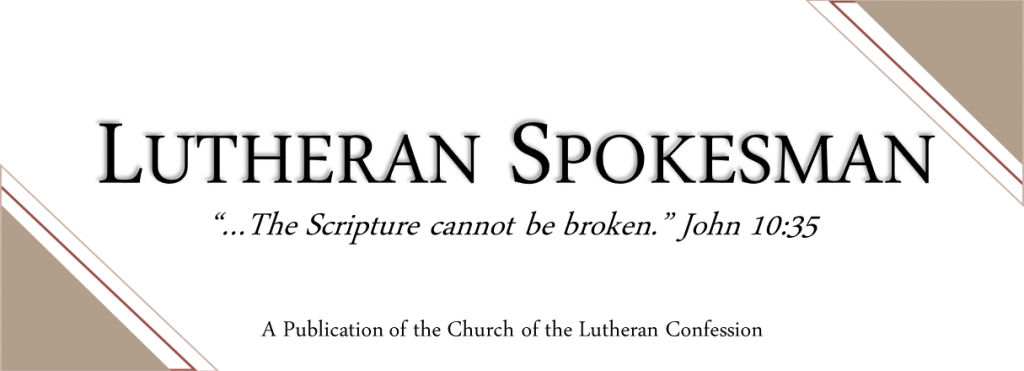A HYMN OF GLORY LET US SING (FOURTEENTH IN A SERIES)
It may be a new year, but do you get the feeling that you’ve done it all before? Just like last year, you’ve watched the thirty-first of December fade out of sight and the first of January come into focus. Unless the Lord returns first, you’ll likely do the same again next year and the year after that.
In music, when certain lines repeat over and over again, it is called a refrain. Thus as the beginning of our year repeats, the words of Christian Keimann’s hymn also repeat through four stanzas: “Joy O joy, beyond all gladness, Christ hath done away with sadness! Hence, all sorrow and repining, For the Sun of Grace is shining!”
For as many times as we throw away the old calendar and put up the new, these words stand faithful and true: Christ puts the joy into each year, the happiness into all our moments. Wondrous things our God has done! We rejoice that He became human in the person of Jesus to live with us and to make His home with us month after month—even forever! We find it fitting that New Year’s Day is still part of the Christmas season (the eighth day of Christmas), for indeed as the new year dawns, we “Tell abroad His goodness proudly Who our race hath honored thus That He deigns to dwell with us.”
Your new year will not be free of suffering and sadness. Jesus told His disciples, “In this world you will have trouble” (John 16:33). You do not know what poverty may lie ahead or what weakness. If you knew the trials ahead of time, you would surely not choose them. Yet when they come, take comfort in this, that your Savior did choose them. “See, my soul, thy Savior chooses Weakness here and poverty; In such love He comes to thee nor the hardest couch refuses.” In becoming human, Jesus chose to feel our temptations, to partake of our sadness, to share in all that stings and hurts us in this life, to accept the “hardest couch,” the most difficult path. Why? Because “All He suffers for thy good, to redeem thee by His blood.” His path to the cross and to your salvation is a Via Dolorosa, a way of sorrows for Him; yet it results in nothing but blessing and good for you.
Can this good news make our new year anything but a year of thanksgiving? “Lord, how shall I thank thee rightly? I acknowledge that by Thee I am saved eternally.” As the years repeat, eternal life’s great refrain repeats, and we give thanks “For God so loved the world that he gave his one and only Son, that whoever believes in him shall not perish but have eternal life” (John 3:16 NIV).
Keimann (1607-1662) knew this gospel well. He graduated from the University of Wittenberg in 1634, just 100 years or so after Martin Luther taught there. He became a distinguished teacher and authored thirteen hymns, two of which have been translated into English (the other being Jesus I Will Never Leave, TLH 365).
He closes this hymn with a prayer: “Jesus, guard and guide Thy members, Fill Thy brethren with Thy grace, Hear their prayers in every place. Grant all Christians, far and near, Holy peace, a glad New Year!”
Yes, dear Jesus, grant us another year under Your loving care, resting in the peace of the forgiveness of sins, and appreciating the joy of Your presence!
David Schaller is pastor of Redeemer Evangelical Lutheran Church in Sister Lakes, Michigan. He also prepares the ‘Bread of Life’ devotions for the Lutheran Spokesman.
Christian Keymann
Born: February 27, 1607 – Pankratz, Bohemia, Germany
Died: January 13, 1662 – Zittau, Germany
Christian Keymann (Keimann) was the son of Zacharias Keimann, a Lutheran pastor at Pankratz, Bohemia. In 1627 he began his studies at the University of Wittenberg, receiving his master’s degree in 1634.
The same year Keymann was appointed the Town Council of Zittau as associate director of the gymnasium, and in 1638 was promoted to the position of Rector.
Keymann was a prominent teacher and author, especially of scholastic writings. His hymns, about thirteen in number, are among the best of his time; they breathe a firm conviction of faith; they are churchly; they are an expression of sound Christian experience and are characterized by exceptional poetic beauty. Almost all of them came into church use. They rank high among those of the 17th century, being of genuine poetic ring, fresh, strong, full of faith under manifold and heavy trials, and deeply spiritual.The melody was composed by James Tilleard (b England, 1827, – d 1876). A second melody by H. Pope has been taken from a Swedish book of chorales, where it was set to J.O. Wallin’s hymn: Stilla jag pea dig vill akta.
Source: ELHHB Website [Dahle, Library of Christian Hymns; Handbook to the Lutheran Hymnal]

